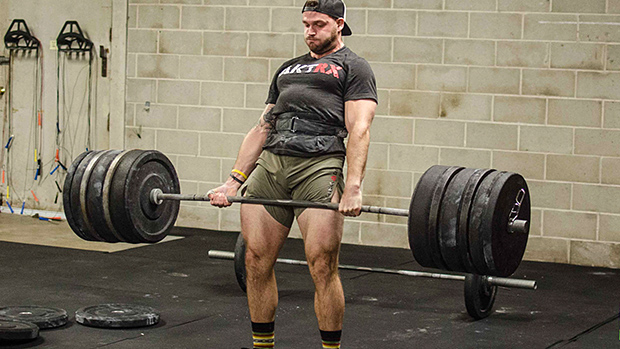What is it about Canada and great strength coaches? For some unknown reason, the Great White North produces some of the world's best coaches and trainers, with Charles Poliquin, Christian Thibaudeau, and Charlie Francis being just a few examples. Now, another young Canadian is beginning to climb into the ranks of the elite: John Paul Catanzaro.
Catanzaro has written several articles for T-Nation in the past; now this walking encyclopedia of kinesiology is ready to answer all your questions about training and program design.
Stretching: It Hurts So Good
Q: I need some good leg stretches, particularly for the hip flexors. Got any good ones?
A: You bet! Here are some of my favorite quad and psoas stretches.
Standing Quad Stretch (PNF)
 |
 |
The goal is to drop the knee further down toward the ground while leaning back.
Side-Lying Quad/Psoas Stretch
 |
 |
If possible, secure the forward foot against an immovable object (like a wall) to lock the pelvis and prevent you from sliding around on the floor. Have your partner stretch you in two different planes as depicted in the photos.
Siff Dynamic Psoas Stretch
 |
 |
 |
Try to extend the length of the lunge (by inching the front foot forward) over several repetitions.
Ballistic Psoas Stretch
 |
 |
Float up and down, then gradually speed up the movement. You can use a chair for support.
Anterior Fascial Chain Stretch
 |
I picked this one up from Dr. Mark Lindsay. By extending the arm, you could exert a greater stretch on the anterior fascial chain.
JP's 4-Stage Static Stretch
 |
 |
 |
 |
Inspired by the late Dr. Siff, the above sequence of photos displays the stretching of all four functions of the psoas major muscle which include hip flexion, external rotation, trunk flexion and (ipsi)lateral flexion. To stretch, simply do the opposite.
Try these out and let me know how they worked for you!
No More Pansy Pull-Ups
Q: When it comes to pull-ups, is it absolutely necessary to be able to do a certain number of bodyweight reps before adding additional weight? Some coaches say you have to get 12 to 15 bodyweight reps before adding weight. Is this really a must? I tend to grow the most when I use heavy weights and keep the reps to about five.
A: Do you have to be able to perform a ton of bodyweight pull-ups before adding weight? Absolutely not! And I agree with you: some people grow much better on heavier weights. You may even want to use supramaximal loads for one single rep per set. Just make sure to do extra sets (six or more) if you do that.
Now, some believe being able to get at least 12 reps with bodyweight before adding additional load is necessary for joint strength. I disagree. It may help to increase muscle hypertrophy and endurance, but for joint strength, the answer is no, it's not necessary.
There are many factors to consider such as training level/age, body weight, body composition, fiber makeup, goals, etc. For example, an advanced trainee who can barely squeeze out 12 bodyweight pull-ups may easily perform two or three reps with 100 pounds around his waist if he's fast-twitch dominant.
 |
(Geek Alert: To calculate the actual load for pull-ups or chin-ups, take 94% of bodyweight since you don't lift the hands (0.7% each) or forearms (2.3% each). So if a 200-pound individual performs pull-ups with 100 pounds hanging from a chin/dip belt, he's actually lifting 288 pounds. Calculation = 200 x 0.94 + 100.)
A lot of guys prefer to use heavier weights for lower reps; in fact, they get bored and weak doing too many repetitions! As the training age increases, the average rep bracket decreases. You've heard Ian King mention that many times.
Now, if your goal is to enter the military or police academy where you're required to get a high number of reps, then you'd have to alter your training style. There are many ways to increase density of training to improve these parameters but it goes beyond the scope of this article. Regarding your situation, my answer is simple: strap on the extra weight and crank 'em out!
Now let me address something I see quite often in the gym. To add weight to pull-ups and chin-ups, a lot of trainees hold a weight between their ankles because they don't have a chinning/dipping belt like the one pictured above. That's okay, but don't do like most of these guys and curl the weight up behind your butt as you pull yourself up. Doing so may rob some neural drive from the prime movers and thus decrease strength.
Contracting the hip extensors will help reduce the amount of hip flexor activity, particularly if the trainee is prone to hiking the knees up during the movement (also known as cheating.) I'd prefer you use a weight belt instead and squeeze a Swiss ball between your heels and buttocks (have your training partner position the ball for you.)
This is a much safer option and it'll keep your form "honest!" You'll feel the difference!
Twice A Day for Mass!
Q: This summer I'd like to gain as much mass as possible. I'm quite motivated and have plenty of time to train. What would you suggest?
A: There are a ton of great high volume programs out there, but since you're a glutton for punishment and have plenty of time, here's one that involves twice a day training. Try it on for size!
Day 1: Morning: Delts & Back
A1) Standing Military Press
A2) Wide Grip Pull-Ups
10 sets x 6 reps each @ 5010 tempo, 90 second rest interval
The designations A1 and A2 mean you superset the two exercises, performing one set of standing press, then one set of pull-ups. Repeat until you complete all required sets.
Day 1: Evening: Chest & Back
A1) Lying Dumbbell Press (semi-supinated)
A2) Seated Cable Row
10 sets x 10 reps each @ 4020 tempo, 60 second rest interval
Day 2: Morning: Quads & Hams
A1) Front Squat
A2) Lying Leg Curl
10 sets x 6 reps each @ 5010 tempo, 90 second rest interval
Day 2: Evening: Quads & Hams
A1) Dumbbell Squat
A2) Seated Leg Curl
10 sets x 10 reps each @ 4020 tempo, 60 second rest interval
Day 3: Off
Day 4: Morning: Biceps & Triceps
A1) Mid-Incline Hammer Curls
A2) Parallel-Bar Dips
10 sets x 6 reps each @ 5010 tempo, 90 second rest interval
Day 4: Evening: Biceps & Triceps
A1) Seated Zottman Curls
A2) Standing Triceps Pressdowns (supinated)
10 sets x 10 reps each @ 4020 tempo, 60 second rest interval
Day 5: Morning: Abs & Calves
A1) Sicilian Crunch
A2) Standing Calf Raise
10 sets x 6 reps each @ 5010 tempo, 90 second rest interval
Day 5: Evening: Abs & Calves
A1) Supine Cable Pull-Ins
A2) Seated Calf Raise
10 sets x 10 reps each @ 4020 tempo, 60 second rest interval
Day 6 - Off
Repeat
Notes
• Eat a minimum of 7 meals a day, one every 2.5 hours.
• You should be taking in 2 grams of protein per pound and up to 15 grams of fish oil every day.
• Only consume one shake on non-training days and two on training days. (In other words, it's better to eat your food than drink it.)
• Consume plenty of BCAA's both before and during your workouts and make sure to take in a 2:1 carb:protein ratio post-workout.
• Plan for restoration as well (massage, stretching, EMS, contrast showers, Epsom salt bathes, etc.).
• Ideally, the second workout should be performed within a 4-6 hour window after the first.
• Perform each morning workout 6 times and then switch to another routine.
Give that program a shot or create one of your own which follows the general guidelines above and you'll definitely add some new mass!
I Feel the Need, the Need to Read
Q: Can you recommend a book about training and hormones?
A: Kraemer has done extensive research in this area. Refer to his book Designing Resistance Training Programs as well as the chapter he wrote in the NSCA's Essentials of Strength and Conditioning.
 |
How to Get a Beefy Back
Q: I like to work a different body part every day. Got a good routine to beef up my back?
A: The following routine exploits different planes/angles, grips, implements and loading parameters that reflect specific fiber orientation and loading capacity. It's a pretty lengthy workout so try to keep the rest intervals to a minimum when switching sides on the unilateral exercises.
You'll notice that you start with six sets on the first exercise and work your way down to one set on the last exercise. Remember, there's an inverse relationship between sets and reps. Additionally, be sure to choose deadlifts (especially pin pulls) and back extensions on leg day and you'll see that back really explode!
A) Sternum Chin-Ups
Sets: 6
Reps: 3
Tempo: 5-0-X-0
Rest: 3 minutes
 |
 |
B) One-Arm Dumbbell Row (semi-supinated)
Sets: 5
Reps: 5
Tempo: 4-0-1-0
Rest: 90 seconds
C) Kneeling Sideways One-Arm Pulldown
Sets: 4
Reps: 8-10
Tempo: 3-0-1-0
Rest: 60 seconds
Stand perpendicular to a high pulley. Grab the handle and kneel down – your arm should be extended at a 45-degree angle. First, retract the shoulder blade and then follow through with your elbow (lower it towards your rib cage.)
D) Seated Cable Rope Row to Neck
Sets: 3
Reps: 12
Tempo: 2-0-1-2
Rest: 45 seconds
 |
E) Wide-Grip Pulldowns to Front
Sets: 2
Reps: 15-20
Tempo: 2-0-1-0
Rest: 30 seconds
F) Decline Semi-Stiff EZ-Bar Pullovers
Sets: 1
Reps: 8/8/8 (drop sets: do 8 reps, lower weight, do 8 reps, lower weight again, then perform 8 final reps
Tempo: 3-0-2-0
Rest: 10 seconds between drops
That should give you a barn door back in no time! Give it a shot!



